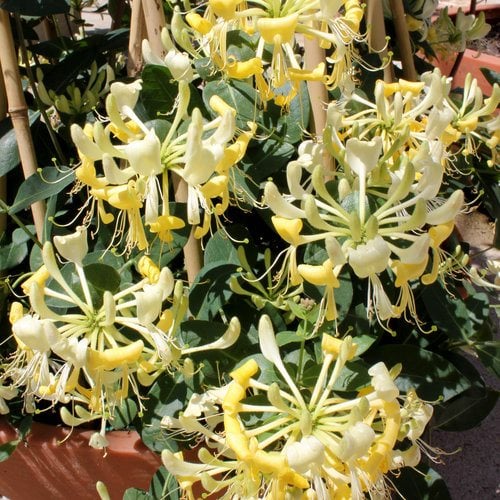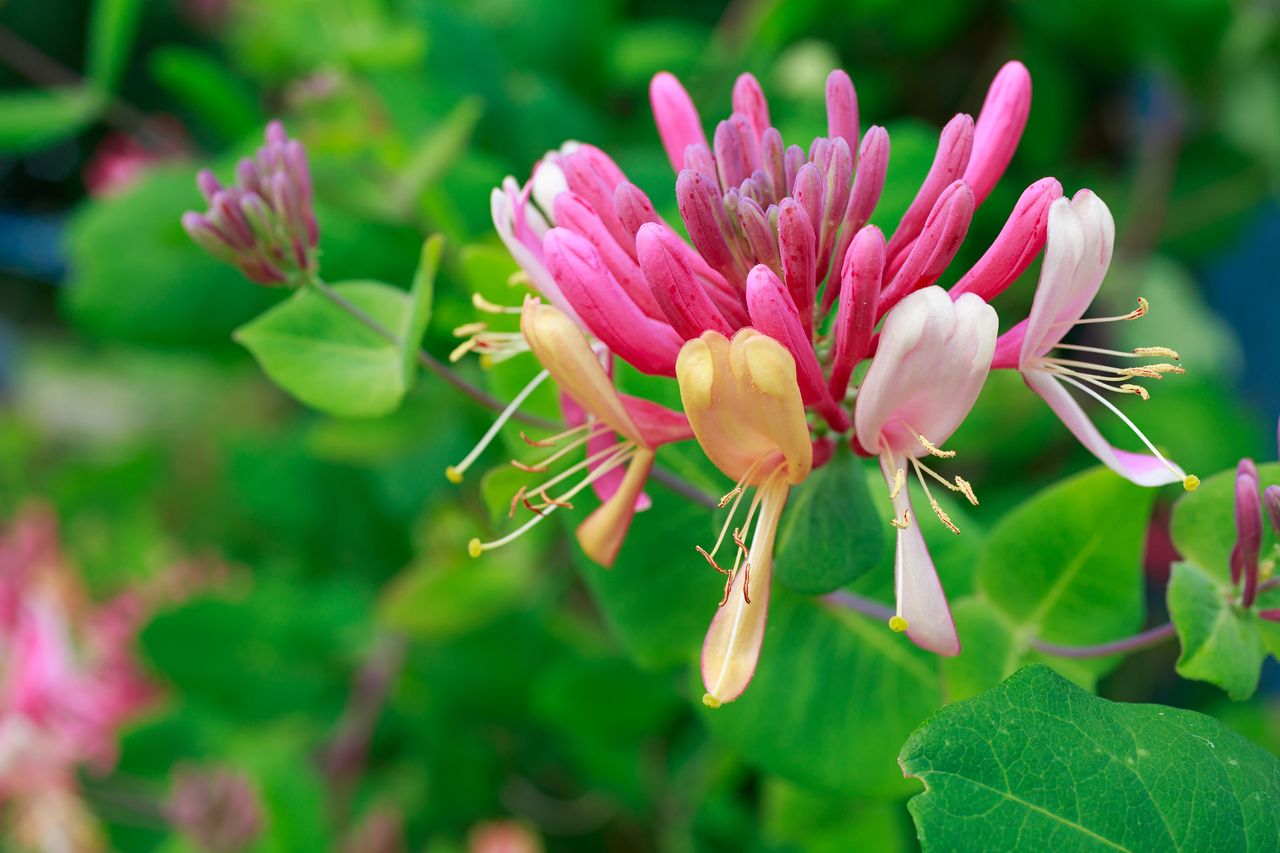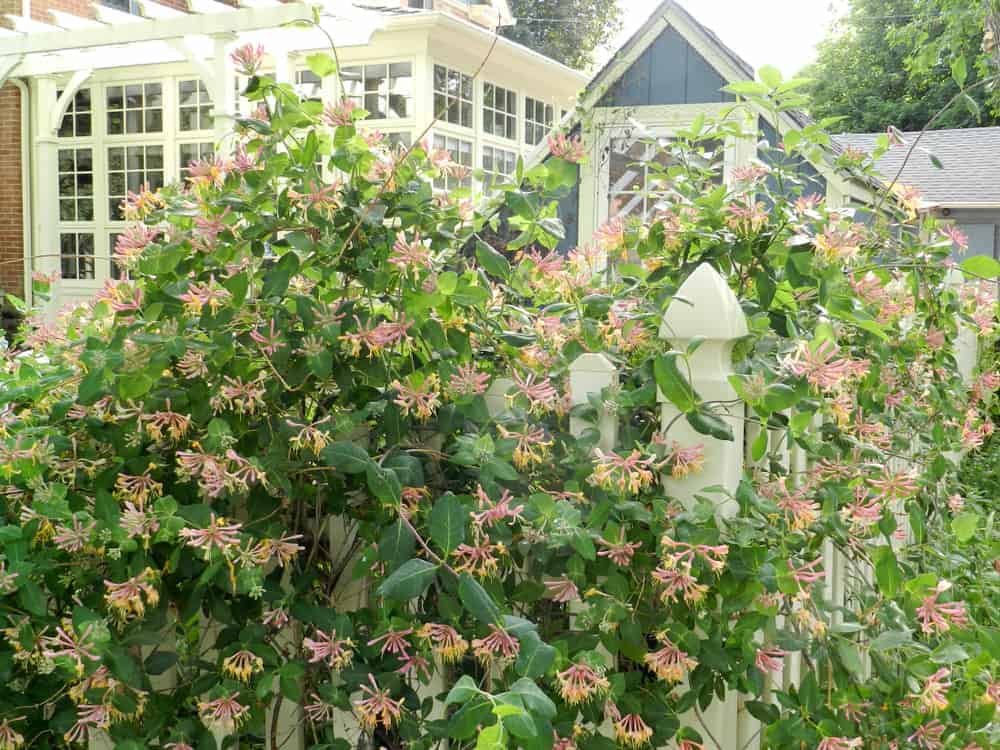Understanding Honeysuckle Vine’s Growing Conditions
Honeysuckle vine is a versatile and fragrant plant that thrives in a variety of conditions. To determine the best location for planting honeysuckle vine, it’s essential to understand its ideal growing conditions. Honeysuckle vine requires full sun to partial shade, with a minimum of four hours of direct sunlight per day. The plant prefers well-draining soil with a slightly acidic to neutral pH, ranging from 6.0 to 7.0.
In terms of moisture, honeysuckle vine is relatively drought-tolerant but performs best with consistent moisture. Aim to provide about 1 inch of water per week, either through rainfall or irrigation. It’s also crucial to avoid overwatering, as this can lead to root rot and other problems.
When considering where to plant honeysuckle vine, it’s also important to think about the plant’s mature size. Honeysuckle vine can grow up to 20 feet tall and 10 feet wide, so it’s essential to provide enough space for the plant to spread out. This will also help prevent overcrowding and promote healthy growth.
By understanding honeysuckle vine’s growing conditions, you can determine the best location for planting and provide the necessary care for optimal growth and flowering. Whether you’re looking to add a fragrant vine to your garden or create a stunning display of blooms, honeysuckle vine is an excellent choice.
When deciding where to plant honeysuckle vine, consider the specific growing conditions of your garden. If you have a spot with full sun and well-draining soil, honeysuckle vine is an excellent option. Alternatively, if you have a shadier area with moist soil, you may want to consider a different location or provide additional support for the plant.
Choosing the Right Spot: Factors to Consider
When deciding where to plant honeysuckle vine, it’s essential to consider several factors to ensure optimal growth and flowering. One of the most critical factors is sunlight. Honeysuckle vine requires at least four hours of direct sunlight per day, but it can tolerate partial shade. If you’re looking to plant honeysuckle vine in a shadier area, consider providing supplemental lighting or pruning nearby plants to allow more sunlight to reach the vine.
Wind protection is another crucial factor to consider when choosing a location for honeysuckle vine. The vine can be sensitive to strong winds, which can cause damage to the plant and reduce its flowering. If you live in a windy area, consider planting honeysuckle vine in a spot that provides some protection from the wind, such as near a building or a group of trees.
Soil quality is also a vital factor to consider when deciding where to plant honeysuckle vine. The vine prefers well-draining soil with a slightly acidic to neutral pH. If your soil is heavy clay or prone to waterlogging, consider raising the bed or adding organic matter to improve drainage.
To assess your garden’s conditions and determine the best spot for planting honeysuckle vine, take a walk around your garden and observe the sunlight, wind, and soil conditions. Consider the mature size of the vine and its potential impact on nearby plants. By taking the time to choose the right location, you can ensure optimal growth and flowering for your honeysuckle vine.
When evaluating potential locations for honeysuckle vine, keep in mind that the vine can grow quite large. Consider the space available and whether the vine will have enough room to spread out. Also, think about the potential impact on nearby plants and whether the vine may compete with them for resources.
By carefully considering these factors, you can choose the perfect spot for your honeysuckle vine and enjoy its beautiful flowers and fragrance for years to come.
How to Plant Honeysuckle Vine for Success
Planting honeysuckle vine requires careful preparation and attention to detail to ensure optimal growth and flowering. Here’s a step-by-step guide on how to plant honeysuckle vine for success:
Step 1: Prepare the Soil – Before planting honeysuckle vine, prepare the soil by loosening it to a depth of 12-18 inches. Add a 2-inch layer of compost or well-rotted manure to improve soil fertility and drainage.
Step 2: Plant at the Right Depth – Plant honeysuckle vine at the same depth as it was in the pot, making sure the crown (where the stem meets the roots) is level with the soil surface. Water well to settle the soil.
Step 3: Water and Mulch – Water honeysuckle vine regularly during its first growing season, providing about 1 inch of water per week. Mulch around the base of the plant to retain moisture and suppress weeds.
Step 4: Provide Support – Honeysuckle vine is a climbing plant and needs support to grow upwards. Provide a trellis or other support system for the vine to climb on. Train the vine to grow up the support by gently twining it around the structure.
Tips for Supporting Honeysuckle Vine – Use a sturdy trellis or support system that can hold the weight of the vine. Train the vine to grow up the support by gently twining it around the structure. Prune the vine regularly to maintain its shape and promote healthy growth.
By following these steps and tips, you can ensure a successful planting of honeysuckle vine and enjoy its beautiful flowers and fragrance for years to come. Remember to choose the right location for your honeysuckle vine, taking into account factors such as sunlight, wind protection, and soil quality.
When deciding where to plant honeysuckle vine, consider the mature size of the plant and its potential impact on nearby plants. Make sure to provide enough space for the vine to grow and spread out, and avoid planting it in areas with poorly draining soil or inadequate support.
Best Locations for Honeysuckle Vine in Different Garden Types
Honeysuckle vine is a versatile plant that can thrive in a variety of garden types. When deciding where to plant honeysuckle vine, consider the specific conditions of your garden and choose a location that provides the right amount of sunlight, wind protection, and soil quality.
Cottage Gardens – Honeysuckle vine is a great addition to cottage gardens, where it can be trained to climb up trellises or arbors. Choose a location that receives partial shade to full sun, and provide well-draining soil with a slightly acidic to neutral pH.
Woodland Gardens – In woodland gardens, honeysuckle vine can be used to create a naturalized look. Plant it near trees or shrubs, where it can climb up and provide a burst of color and fragrance. Make sure to provide enough space for the vine to grow and spread out.
Container Gardens – Honeysuckle vine can also be grown in container gardens, where it can be trained to climb up trellises or other supports. Choose a container that is at least 6-8 inches deep, and provide well-draining soil with a slightly acidic to neutral pH.
When incorporating honeysuckle vine into existing garden designs, consider the mature size of the plant and its potential impact on nearby plants. Make sure to provide enough space for the vine to grow and spread out, and avoid planting it in areas with poorly draining soil or inadequate support.
In addition to considering the specific conditions of your garden, also think about the style and theme of your garden. Honeysuckle vine can be used to create a romantic and whimsical look, or a more formal and structured look. By choosing the right location and providing the right care, you can enjoy the beauty and fragrance of honeysuckle vine in your garden.
When deciding where to plant honeysuckle vine, also consider the potential impact on nearby plants. Make sure to plant it in a way that minimizes competition for resources and prevents overcrowding. By providing the right care and attention, you can enjoy the beauty and fragrance of honeysuckle vine in your garden for years to come.
Considerations for Planting Honeysuckle Vine Near Other Plants
When deciding where to plant honeysuckle vine, it’s essential to consider the mature size of the plant and its potential impact on nearby plants. Honeysuckle vine can grow quite large, up to 20 feet tall and 10 feet wide, so it’s crucial to provide enough space for the vine to grow and spread out.
Planting honeysuckle vine near other plants can be beneficial, as it can provide shade, support, and a naturalized look. However, it’s essential to choose plants that are compatible with honeysuckle vine and won’t compete with it for resources. Some good companion plants for honeysuckle vine include roses, lavender, and coneflowers.
When planting honeysuckle vine near other plants, make sure to provide enough space between them to prevent overcrowding. A general rule of thumb is to plant honeysuckle vine at least 3-5 feet away from other plants. This will give the vine enough room to grow and spread out without competing with other plants for resources.
It’s also essential to consider the growth habits of nearby plants when deciding where to plant honeysuckle vine. For example, if you’re planting honeysuckle vine near a shrub or tree, make sure to provide enough space for the vine to grow up and around the plant without causing damage.
By considering the mature size of honeysuckle vine and its potential impact on nearby plants, you can create a beautiful and thriving garden that showcases the vine’s beauty and fragrance. Remember to choose a location that provides the right amount of sunlight, wind protection, and soil quality, and to provide enough space for the vine to grow and spread out.
When deciding where to plant honeysuckle vine, also consider the potential impact on nearby plants. Make sure to plant it in a way that minimizes competition for resources and prevents overcrowding. By providing the right care and attention, you can enjoy the beauty and fragrance of honeysuckle vine in your garden for years to come.
Common Mistakes to Avoid When Planting Honeysuckle Vine
When planting honeysuckle vine, there are several common mistakes to avoid in order to ensure healthy growth and optimal flowering. One of the most common mistakes is planting the vine in poorly draining soil. Honeysuckle vine prefers well-draining soil, and planting it in soil that is prone to waterlogging can lead to root rot and other problems.
Another common mistake is failing to provide adequate support for the vine. Honeysuckle vine is a climbing plant and needs something to climb on in order to grow and thrive. Providing a trellis or other support system can help the vine grow upwards and produce more blooms.
Planting honeysuckle vine in a location that receives too much shade is also a common mistake. While honeysuckle vine can tolerate some shade, it prefers full sun to partial shade in order to produce the most blooms and fragrance.
Not providing enough space for the vine to grow is another common mistake. Honeysuckle vine can grow quite large, up to 20 feet tall and 10 feet wide, so it’s essential to provide enough space for the vine to grow and spread out.
By avoiding these common mistakes, you can ensure healthy growth and optimal flowering of your honeysuckle vine. Remember to choose a location that provides the right amount of sunlight, wind protection, and soil quality, and to provide enough space for the vine to grow and spread out.
When deciding where to plant honeysuckle vine, also consider the potential impact on nearby plants. Make sure to plant it in a way that minimizes competition for resources and prevents overcrowding. By providing the right care and attention, you can enjoy the beauty and fragrance of honeysuckle vine in your garden for years to come.
Maximizing Honeysuckle Vine’s Fragrance and Flowering
Honeysuckle vine is known for its beautiful, fragrant flowers and ability to attract pollinators. To maximize the vine’s fragrance and flowering, it’s essential to provide the right growing conditions, pruning, and fertilizing.
Providing the right growing conditions is crucial for maximizing honeysuckle vine’s fragrance and flowering. The vine prefers full sun to partial shade, well-draining soil, and a slightly acidic to neutral pH. Make sure to plant the vine in a location that receives the right amount of sunlight and has well-draining soil.
Pruning is also essential for maximizing honeysuckle vine’s fragrance and flowering. Prune the vine regularly to maintain its shape, promote healthy growth, and encourage more blooms. Remove any dead or damaged stems, and cut back the vine to encourage new growth.
Fertilizing is also important for maximizing honeysuckle vine’s fragrance and flowering. Use a balanced fertilizer that is high in phosphorus to promote blooming and fragrance. Apply the fertilizer in the spring and again in the summer to encourage healthy growth and blooming.
In addition to providing the right growing conditions, pruning, and fertilizing, there are several other tips to maximize honeysuckle vine’s fragrance and flowering. Make sure to water the vine regularly, but avoid overwatering, which can lead to root rot and other problems. Also, avoid planting the vine in areas with high winds, which can damage the stems and reduce blooming.
By following these tips, you can maximize honeysuckle vine’s fragrance and flowering and enjoy the beauty and fragrance of this beautiful vine in your garden. Remember to choose a location that provides the right amount of sunlight, wind protection, and soil quality, and to provide enough space for the vine to grow and spread out.
When deciding where to plant honeysuckle vine, also consider the potential impact on nearby plants. Make sure to plant it in a way that minimizes competition for resources and prevents overcrowding. By providing the right care and attention, you can enjoy the beauty and fragrance of honeysuckle vine in your garden for years to come.
Tips for Training and Pruning Honeysuckle Vine
Training and pruning honeysuckle vine is essential to maintain its shape, promote healthy growth, and encourage more blooms. Here are some tips on how to train and prune honeysuckle vine:
Training Honeysuckle Vine – To train honeysuckle vine, start by providing a trellis or other support system for the vine to climb on. Gently twine the stems around the support, making sure not to damage the plant. As the vine grows, continue to train it to climb up the support, pruning any stems that are growing outside of the desired area.
Pruning Honeysuckle Vine – Pruning honeysuckle vine is essential to maintain its shape and promote healthy growth. Prune the vine in the late winter or early spring, removing any dead or damaged stems. Cut back the vine to encourage new growth and promote more blooms.
Best Pruning Tools and Techniques – When pruning honeysuckle vine, use sharp, clean pruning tools to prevent spreading diseases. Make clean cuts just above a leaf node, and remove any weak or spindly growth. Use a pair of loppers or pruning shears to prune the vine, and consider using a pruning saw for thicker stems.
Timing of Pruning – The timing of pruning honeysuckle vine is crucial to promote healthy growth and encourage more blooms. Prune the vine in the late winter or early spring, before new growth begins. This will help promote new growth and encourage more blooms.
By following these tips, you can train and prune honeysuckle vine to maintain its shape, promote healthy growth, and encourage more blooms. Remember to provide the right growing conditions, including full sun to partial shade, well-draining soil, and a slightly acidic to neutral pH.
When deciding where to plant honeysuckle vine, also consider the potential impact on nearby plants. Make sure to plant it in a way that minimizes competition for resources and prevents overcrowding. By providing the right care and attention, you can enjoy the beauty and fragrance of honeysuckle vine in your garden for years to come.







